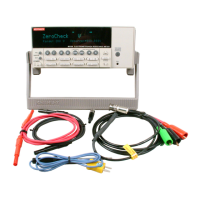IEEE-488 Reference
3-36
Bit 5, Event Summary Bit (ESB) — Set bit indicates that an enabled standard event has oc-
curred. The event can be identified by reading the Standard Event Status Register using the
*ESE? query command (see paragraph 3.11.2).
Bit 6, Master Summary Status (MSS) / Request Service (RQS) — Set bit indicates that one
or more enabled Status Byte conditions have occurred. The MSS bit can be read using the STB?
query command, or the occurrence of a service request (RQS bit set) can be detected by per-
forming a Serial Poll.
Bit 7, Operation Summary Bit (OSB) — Set bit indicates that an enabled operation event has
occurred. The event can be identified by reading the Operation Event Status Register using the
:STATus:OPERation? query command (see paragraph 3.20 for details).
3.11.13 *TRG — trigger Send a GPIB trigger to the Model 6517A.
Description The *TRG command is used to issue a GPIB trigger to the Model 6517A. It has the same effect
as a group execute trigger (GET).
The *TRG command is used as an arm, scan and/or measure event to control operation. The
Model 6517A reacts to this trigger if GPIB is the programmed control source. The control
source is programmed from the :TRIGger subsystem (see paragraph 3.23).
*TRG can also be used as the pre-trigger for buffer operation.
3.11.14 *TST? — self-test query Run the self-test and acquire the Result.
Description This query command is used to perform a checksum test on ROM and places the coded result
(0 or 1) in the Output Queue. When the Model 6517A is addressed to talk, the coded result is
sent from the Output Queue to the computer.
A returned value of zero (0) indicates that the test passed, and a value of one (1) indicates that
the test has failed.
3.11.15 *WAI — wait-to-continue Prevent the execution of commands until all previous commands are completed.
Description There are two types of device commands; Sequential commands and Overlapped commands. A
Sequential command is a command whose operations are allowed to finish before the next com-
mand is executed. An Overlapped command is a command that allows the execution of subse-
quent commands while device operations of the Overlapped command are still in progress. The
*WAI command is used to hold off the execution of subsequent commands until the device op-
erations of all previous Overlapped commands are finished. The *WAI command is not needed
for Sequential commands.
There are three Overlapped commands in the Model 6517A; :INITiate, :INITiate:CONTinuous
ON and *TRG.
NOTE
See *OPC, *OPC? and *TRG for more information.
The :INITiate commands take the Model 6517A out of the idle state. The device operations of
:INITiate are not considered complete until the Model 6517A goes back into idle. By sending

